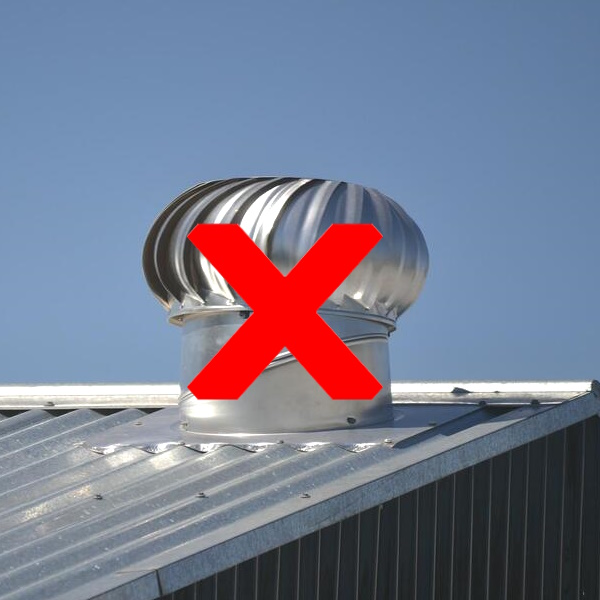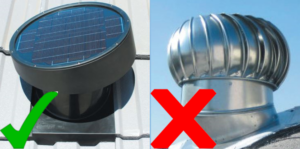Energy Saving Tips
STC Solar Rebate
STC Solar Rebate is a government incentive that makes solar more affordable for Australian…

When you think of roof ventilation, the image of a roof whirlybird comes to mind. The trusty old favourite is cheap, easy to install, but does it get the job done? Only sometimes – when the wind is blowing.
Good roof ventilation should circulate the air to cool your home in summer, reducing the load on your air-conditioning. It also extracts moisture from your roof space for a healthy home
But just because it’s easy to install with no associated running costs doesn’t make the whirlybird the smartest choice for your home.
Before putting your money down you need to be aware of the main drawbacks of a roof whirlybird.
Whirlybirds rely on wind to function. Cheap? Yes. Effective? Not really.
If you live somewhere with too little or too much wind, this will likely compromise the effectiveness of the whirlybird.
On cold windy winter days and nights, your roof whirlybird will be working overtime at extracting the heat you’re desperately trying to keep in. On hot days when there’s no breeze, they’re not working at all, leaving your home full of hot, stale air. Your air-conditioner or heater will be working overtime, driving your power consumption up.
They work when you don’t want them to and don’t work when you need them most.
An average roof whirlybird can’t compete with other options when it comes to air extraction.
The volume of air that most homes need for an effective air change is more than roof whirlybirds are capable of. This often means people need to install multiple whirlybirds on their roof.
On the surface the whirlybird looks cost effective, but the expenses add up.
Generally, more than one roof whirlybird needs to be installed for a home to achieve effective air ventilation. And while an inexpensive whirlybird at Bunnings can be as low as $129, the installation costs (in Sydney) are as expensive as $429 for the first unit and $149 for subsequent units installed on the same day. That means you’re looking at $558 for the cheapest whirlybird plus install, then an extra $278 for every subsequent whirlybird your home needs.
A MaxBreeze MB25 standard Solar Roof Ventilation Fan can do the work of several whirlybirds and is $718 for the unit and a standard single storey install.
With a primary focus on air ventilation, whirlybirds weren’t designed to remove moisture from roof spaces and have limited effectiveness in this area. If extracting moisture from your roof space is of high importance to help avoid mould, you would need multiple whirlybirds or an alternative roof ventilation solution.
Whirlybirds unfortunately require regular maintenance to ensure optimal air ventilation. The design includes open vents which are prone to dust, dirt, storm damage and debris. Periodic cleaning to remove any obstructions and lubrication are important to keep the whirlybird effective.
Whirlybirds have a high profile that protrudes and can alter the roofline, making it less aesthetically pleasing and more old fashioned looking than the other roof air ventilation options on the market.
Let’s put the old Whirlybird head-to-head with the MaxBreeze solar roof fan and see which comes out on top.
Characteristic | Whirlybird | MaxBreeze Solar Fan |
Wind Dependent | No breeze, no air extraction. On a hot, still day the roof whirlybird won’t work, leaving your home hot and requiring more air conditioning. | Works with or without wind, quietly extracting air to cool your home whin the sun is shining. It onlt urns on when the roof heats up. |
Air Extraction | Inefficient at moving large amounts of air. | MaxBreeze MB250 can move up to 7 times as much air as the whirlybird. |
Cost | $558 for a cheap roof whirlybird unit + typical install. And then an extra $278 for every subsequent whirlybird your home needs. And you will need more than one! | $718 for the MaxBreeze MB250 unit fully installed. Only one unit required for most standard sized homes. |
Moisture Removal | Ineffective at moisture removal. | Powerful ventilation exhaust fan means the MaxBreeze is great at extracting moisture from your roof space. |
Mainenance | Requires maintenance to keep vents clear and operational. They are also prone to rust. | Sleek design minimises risk of debris or dirt entering the vents. |
Aesthetics | High profile protrudes from roofline and looks old fashioned. | Sleek modern design is less disruptive to your home’s roof. |

So is the Roof Whirlybird worth it? When we consider that depending on how the wind is blowing it can remove too much hot air in winter or too little in summer, is ineffective at removing moisture, and homes often require more than one unit; it’s not really the optimal roof ventilation system. Don’t waste your money on a second-rate roof ventilation solution.
For a slightly larger upfront investment, when you purchase a MaxBreeze you get a superior solution. A roof ventilation system that will help to cool your home in summer, remove moisture from the roof, and run for free using solar power while saving you money on energy bills.
For more information on solar roof ventilation exhaust fan options, call SolarBright and talk to one of our energy and ventilation consultants.
Take a Look
Energy Saving Tips
STC Solar Rebate is a government incentive that makes solar more affordable for Australian…
Solar Battery
A Virtual Power Plant is a network of connected solar batteries, typically located in…
Solar Panels
Installing solar panels is one of the quickest and most effective ways to start…